What is the best way to make nests for chickens. What size nest is needed for laying hens
It would seem that the process of breeding domestic chickens in a private household does not require much effort from the poultry breeder. However, to get really high results, the productivity of chickens, it is recommended to study all the necessary nuances. Particular attention is paid to the arrangement of the chicken coop for birds from the inside. Where to put nests for laying hens, how and what sizes to equip feeders and drinkers (they are not just necessary, but mandatory). All this requires a serious approach.
Types and benefits
It is not difficult to build nests for laying hens with your own hands, if you understand the basic principle. But before equipping nests for domestic chickens, it is recommended to find out which types of them are distinguished and which of them are most often preferred by domestic farmers.
There are several types of chicken nests:
- in the form of boxes. What does this kind of egg storage look like? This is a small wooden house with an opening at the top. What is remarkable about this design is the ability to provide comfortable conditions for a laying hen. In a cozy shaded room, she will be able to rush much more intensively, since any laying hen prefers a calm atmosphere and the absence of bright lighting. Another advantage of this do-it-yourself chicken nest is their practicality. In addition, young hens can be taught to it without much effort. To do this, they are placed in the device and the structure is briefly closed;
- from improvised materials. Let's say you spontaneously decided to start breeding domestic chickens in the courtyard, or you prefer to devote time to this only in the summer. In this case, the construction can be carried out randomly and with the help of improvised components. This option will be quite optimal for farmers who do not contain a large number of poultry in the chicken coop. What is used as a substitute? You can get by with cardboard boxes, baskets, boxes. Chickens quickly get used to their home. Fulfill one key condition - all DIY alternative chicken nests must be intact and clean. In this case, the birds will not even be able to notice the difference;
- with egg box. The dimensions of this type may vary, depending on the technology you use for their manufacture or the use of certain materials. However, the essence of such a device is that the laying hen could not make much contact with the egg (for example, some chickens peck their eggs). That is, farmers attach special pallets or some kind of containers along which the eggs will roll down. A nest for hens with an egg collector is considered the best option for any farmer.
It is up to you to decide which type of chicken nests to give preference to. It all depends on the characteristics of growing poultry in a particular area, and also solely on your intentions.
Video "The advantages of perches for chickens with an egg collector"
From the video you will learn why you need such a nest with an egg collector.
Size Requirements
What should be the size of a chicken nest? First of all, pay attention to the species features of the poultry breed you breed in the courtyard. Some layers will not need much space. But there are also representatives of larger varieties of chickens, over providing a spacious "living space" for which you will need to try. Remember, if a do-it-yourself nest for laying hens is not convenient, she will not be able to actively lay eggs in it. 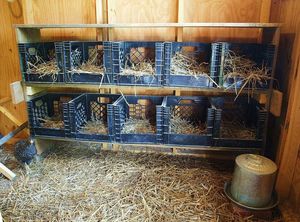
Another important point - in the chicken coop it is recommended to have a roof at an angle of 45 degrees. This is necessary so that the poultry do not get used to sitting on top of the house. As for the right time to install new chicken nests, such nuances should be considered even at the stage of building a chicken coop. Thus, the birds will get used to the conditions that are foreign to them much faster.
Placement rules
You can make nests for laying hens with your own hands without unnecessary difficulties, but the process of arranging a quality chicken coop does not end there. After that, it is advisable to think carefully about where to place nests for laying hens with an egg collector. Any nest for a chicken is placed in accordance with the physiological needs of poultry. 
- it is desirable to place it at a height of at least 30 cm;
- in order for the chicken to quickly get used to her new home, it is advisable to consider the presence of flooring in a box or box. For this, poultry farmers mostly use straw or sawdust;
- it is very important that the floor is constructed from a fine mesh. In the absence of such a base, it is advisable to make small ventilation holes in the floor;
- if we consider in more detail the optimal zones for the location of nests in the chicken coop, these include quiet secluded corners where bright light does not enter;
- It is not recommended to mount homemade chicken nests directly on the wall. Firstly, in this position, the structure you built is unlikely to last long, and secondly, in winter, the boxes will always remain cold.
Knowing how to make a nest for laying hens, and how to place it in the coop correctly, you can follow all the recommendations of experts.
Manufacturing instructions
How to make nests with an egg collector? First you need to make a plan construction works and prepare drawings. After that, it will be possible to purchase materials and proceed to the implementation of your idea. 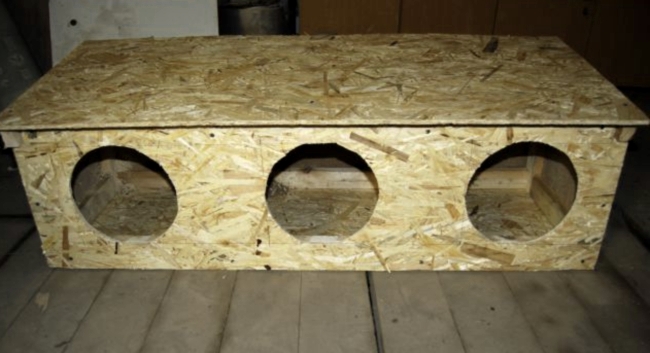
It is not worth inviting specialists to work, since you can do all this yourself. The main thing is to get the tools and follow the drawings.
Construction in the form of boxes
How to make nests for chickens using ordinary boxes for this? In the course of construction work, you will need plywood, timber, fasteners, sandpaper, an electric jigsaw, a screwdriver, and a hammer. Nest size for laying hens will vary depending on the size of the poultry. Such a construction solution will cost you much less than buying special nests in a store.
Egg box design
How and what size to build a nest with an egg collector with your own hands? 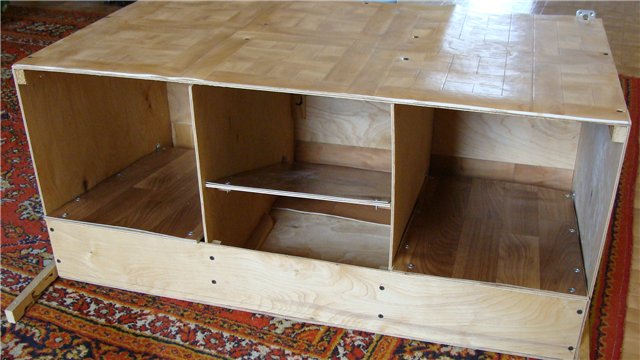
In general, the design appearance somewhat reminiscent of cardboard boxes or boxes converted into chicken "houses", with the exception of one important feature: the bottom in this instance should have a slight slope.
This way the eggs will roll into the tray and you can pick them up without disturbing the hen. Essentially, you need to construct a device with a double bottom. This is not so easy to do, but the result will certainly satisfy you. It is also recommended to give preference to this type of nest so that chicken eggs do not peck. Remember, chicken nests made according to the rules can greatly increase the productive characteristics of poultry. Therefore, if you want your chickens to rush intensively in the nests, and the devices themselves turn out to be durable and strong, build them thoroughly and with high quality.
The arrangement of any chicken coop involves the presence of nests for chickens in it. The quality of such nests determines both the quality and the quantity of whole eggs that the hens lay. To ensure the most comfortable conditions, you can do the construction of nests with your own hands and figure out how to make the nest correctly, having thought through every detail.
First of all, you should familiarize yourself with some rules that will help in the further process of arrangement:
The place where eggs are laid should be dry and warm.
- It is recommended to locate nests in a place with a predominance of shade, where the sun's rays do not reach.
- The place where eggs are laid should be dry and warm, which can be provided by laying straw or sawdust. Based on the practical experience of farmers, it is better to use sawdust, because this kind of bedding is not thrown out of the nest by birds.
- The level of sawdust or straw should not exceed the edges of the sides so that the eggs do not roll out and fall.
- When constructing nests, it is recommended to make the bottom of the mesh. Thanks to this, ventilation of the litter will be ensured for a long time.
- The installation site should be chosen, starting from the opposite: places in which humidity prevails and cold air passes through will not work.
- Attaching nests to the walls is not recommended, as there is a risk for birds to catch a cold, and the nests will have to be changed or reconstructed more often.
- The completed nest structure should not have any rough surfaces, protruding nails or other sharp elements, because the bird may be injured.
- The calculation of the number of nests is carried out based on a ratio of 5:1, i.e. 5 hens per nest.
In addition to the rules, it is worth understanding which nests to make best.
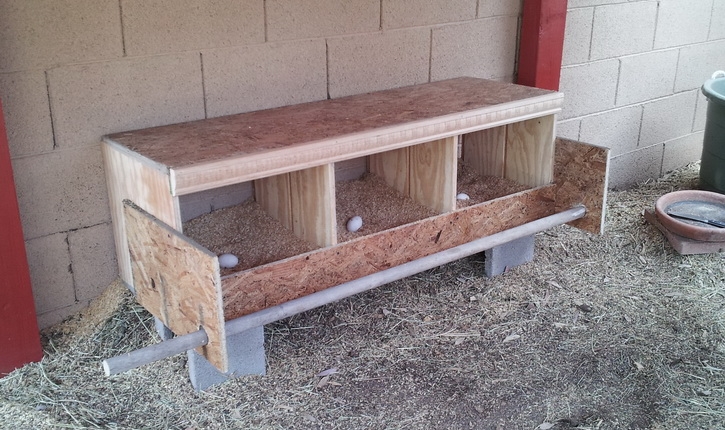 There are three various designs chicken nests.
There are three various designs chicken nests. The characteristics of the three possible types of nests are as follows:
| Type of nest | Characteristic |
| Nest boxes | The design of this type of nest is very simple - it is an ordinary box in which a hole is made for the free passage of the bird inside. The number of cells in this installation may vary. A good advantage of box nests is the easy learning of chickens to rush in the nest, you just have to close the bird in such a nest for a short period of time, and there will be no problems in the future. |
| From improvised materials | This variety is mainly used by novice poultry farmers who have not yet fully equipped the chicken coop. It is also a good option for those who keep a small number of birds, because the nests are short-lived. But in some cases, there is nothing left but to make a nest for laying hens from ordinary boxes or baskets. The main condition for this is to choose elements without defects, having previously cleaned them of debris and dust. It is also worth remembering that space with this type of nests cannot be rationally used. |
| Egg nests | The most optimal type of nests, although laborious. In this case, you will need to carefully familiarize yourself with the process and understand how to make nests yourself, because the design involves spontaneous rolling out of eggs so that birds do not peck at them. For the construction, special pallets are needed into which the eggs will roll. In addition, you can make a nest by equipping it with a funnel-shaped hole in the center, or with an inclined floor surface. |
Based on the size of the chickens, the parameters of the nests are selected. The main task in this case is to ensure that the birds freely enter the nest and stay inside it. The size for laying hens is 25x35x35 cm.
 The size of one nest for laying hens is 25x35x35 cm.
The size of one nest for laying hens is 25x35x35 cm. It is best to first make drawings, on which all the necessary parameters of the structure are noted. In addition to the above, it is worth considering the height of the nut, which should be at least 5 cm, and the take-off shelf with an optimal section of 5x2 cm, it is located at a distance of 10 cm from the entrance.
Important. The nest cover is set at an angle of 45 degrees to prevent birds from sitting on the nest.
For the simplest nest, any box is suitable, for example, a plastic vegetable box and a sheet of plywood. The latter can be replaced with a different material that is necessary for the construction of the curtain. By laying a little flooring and providing a blackout, you can get a simple nest design.
 The easiest nest option for laying hens is wooden or plastic boxes.
The easiest nest option for laying hens is wooden or plastic boxes. It should be understood that the quality of such nests is not too good. In addition, they will have to be placed on the ground, which will negatively affect the health of birds and reduce their level of productivity.
Important. In an uncomfortable nest, a bird will not lay eggs. This is worth remembering when deciding on the type of design.
For the construction of such nests you need to use:
- plywood or board;
- timber;
- fasteners;
- sandpaper;
- jigsaw;
- screwdriver;
- hammer.
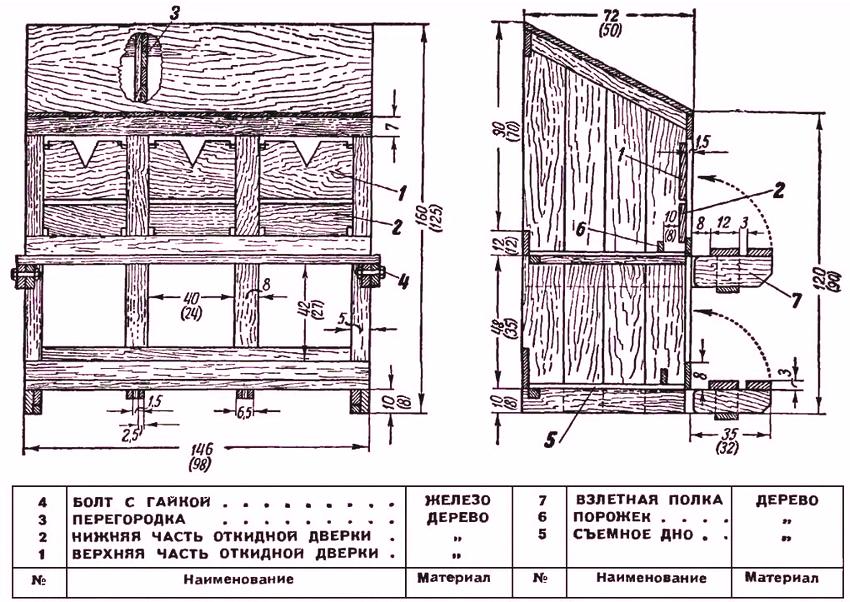 The photo shows a drawing of bunk nests for laying hens.
The photo shows a drawing of bunk nests for laying hens. The step-by-step instructions for constructing are as follows:
- Initially wooden material needs to be sanded.
- Next, cut all the blanks, starting from the required dimensions. To calculate the required number of cells, it is necessary to divide the length of the entire structure by the width of one of the cells. Height (tiered) is determined similarly.
- The next step is to connect all the blanks with nails.
- The inner side of the boxes must be strengthened with a beam. Fastening is carried out at the corners.
- After that, an inlet is constructed, which can be cut out.
- Next, a threshold is made, the width of which should not be less than 10 cm. The connection of this element is carried out with the lower part of the boxes along the entire length.
- The take-off platform is fixed at a distance of 10 cm from the inlet.
- If nests are built in several tiers, then it is worth taking care of building a ladder to each of them.
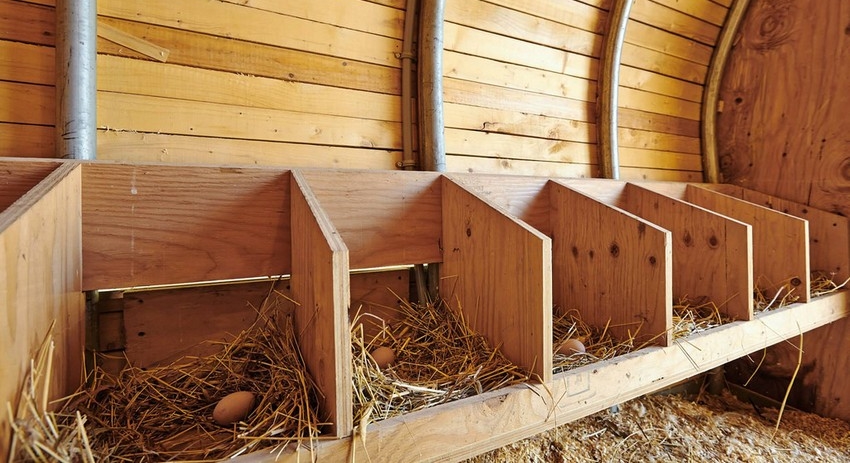 The inner walls of the nests are reinforced with bars.
The inner walls of the nests are reinforced with bars.
If you want to build this kind of nest, you should decide on a variant of this design. It will be a little more difficult to make this kind of nest, but it will provide more free time for the farmer and preserve the integrity of the chicken eggs.
Double bottom
To the materials indicated in the previous version, the following should be added for the construction process:
- upholstery material on a pallet;
- scissors.
The nesting process is as follows:
 The depth of the pallet is made 10 cm more than the depth of the nests.
The depth of the pallet is made 10 cm more than the depth of the nests. - First of all, they build an ordinary nest, as in the previous case, taking into account all the nuances of such a process.
- A feature of this design is the bottom, which must be attached taking into account the angle of inclination relative to the rear wall of 5 degrees. At the same time, the distance from the wall to the bottom is left such that the eggs roll freely, passing through it.
- Next, a pallet is built, which is immediately upholstered with upholstery. To do this, you can use felt, rubber or linoleum, turned inside out.
- The depth of the pallet is 10 cm more than the depth of the nests, this will allow you to collect eggs from the outside.
- The pallet is also fixed at an inclination of 5 degrees.
egg container
Using the diagram below, you can build your own design.
The material for manufacturing is similar, and the installation process is as follows:
- Initially, a box is assembled in which the bottom is placed with a slope of 10 degrees.
- The front part of the structure is closed, an inlet is preliminarily cut out in it.
- A hole is cut out on the lower part of the back wall, the size of which is slightly larger than the egg.
- Next, the egg container is installed, which is covered with a soft material on the inside to ensure the integrity of the eggs during rolling.
 The photo shows a nest for a laying hen with an egg collector in the form of a container.
The photo shows a nest for a laying hen with an egg collector in the form of a container. Important. There should not be a lot of upholstery material, it can become an obstacle for eggs to roll into the pan.
Attaching nests can be done in two ways:
- on special supports, which are made in advance;
- to the walls, excluding their contact with the nests.
If there are no questions with mounting on special supports, then how to attach the nest to the wall, it is worth understanding in more detail:
 Nests are attached to the wall or on special supports.
Nests are attached to the wall or on special supports. - A board with parameters 30x4x2 cm is attached to the wall. It will serve as a base and support for further fixing the structure.
- The second board with similar dimensions is fixed, observing an angle of 45 degrees. In this case, the distance from one board to another must be at least 40 cm. The boards diverge from top to bottom.
- Further, with an indent of 45 cm, a similar structure is attached, only the convergence of the boards will be on top.
- Nests are attached to the resulting bases, in which there are compartments. They need to be fixed with screws to the bar located at an angle.
As an option for arranging a chicken coop, you can choose the construction of nests of a hinged type. The advantage of such a structure is its accessibility for the farmer, because there is no need to go for eggs. The only caveat is the need for insulation.
Important. Making this kind of nest is possible only in the case of a wooden chicken coop.
You can build a hanging nest in the following way:

Such a process at first glance may seem complicated, but in fact, special efforts are not needed for this. It is only necessary to provide the necessary conditions for the hen, and she herself will be placed in the nest.
 If all conditions are created for the hen, she herself will go to the nest for laying eggs.
If all conditions are created for the hen, she herself will go to the nest for laying eggs. When constructing nests, one should carefully monitor both the size of the openings for entering the nest and the parameters of the nest itself, namely, to ensure free access and placement of the bird in it. In addition, it is worth maintaining the temperature at 10-12 degrees and ensuring the cleanliness of the nest.
It is also worth bringing the nests in before placing the hens in the house. It is very important to provide nests with dry bedding and place them in a comfortable place. It is best to place the nests along the side wall, while the short one is located on the hinge side of the doorway. This will avoid drafts and save optimal temperature, and, accordingly, the state of health of birds.
We offer for viewing a video instruction on assembling nests for laying hens. We wish you a pleasant viewing!
Those people who live in private houses are mainly engaged in breeding animals and birds. As a rule, chickens are bred more often. It is easy to care for him, and as a result, he eats his eggs and meat. In order for the eggs to always be clean, and the chickens to lay in one place, it is necessary to equip the chicken coop with nests. It's easy to do.
Very just make nests for laying hens in the form of a box with their own hands. For this you will need the following materials:
- Board or plywood;
- Nails;
- Hammer;
- Hacksaw.
How to make a nest for laying hens:
- Cut the prepared board (plywood) into equal parts.
- Using a hammer and nails, connect the resulting elements so that you get a box.
- Straw should be laid in the box made and installed thirty centimeters from the floor.
- To the box, if desired, you can attach a small ladder. So, it will be easier for chickens to get into the nest.
Laying hen nest dimensions
 chicken nest must fit the following dimensions: the depth of the nest should be more than forty centimeters. Height and width thirty centimeters.
chicken nest must fit the following dimensions: the depth of the nest should be more than forty centimeters. Height and width thirty centimeters.
The resulting design must be installed in a dark and warm place in the chicken coop. The size of the nest should fit the hen, and it should also be comfortable. If the chicken does not want to rush in it, then she does not like it and should be redone.
Where and how to install nests
For the hen to lay in the nest you made for her, you need to know a few rules:
- It is better to install such structures in a dark place and away from drafts.
- For bedding the best option is straw or sawdust;
- The bottom is better to do from the grid. This is necessary for ventilation.
- It is necessary to hang the house at a distance of at least thirty centimeters from the floor, and you also need to take into account that you should not nail it to the wall.
- It is not worth installing the structure in wet places. This can lead to illness in chickens.
- Access to eggs and bedding should be convenient.
Nests for laying hens with an egg collector (drawing)
Often the owner of his birds, due to various circumstances, cannot regularly visit the chicken coop and collect eggs. In this case you need egg box design which you can make yourself. This nest is also called a "double bottom nest". Such a device becomes Lately more and more popular. It differs only in that its bottom has a slope. Thanks to the slope, the eggs roll to the right place.
In order to make such a device, you will need:
- Make a regular box out of plywood or boards.
- The bottom should have a slope of approximately ten degrees.
- Make a hole in the tray and attach the tray.
- Lay straw or sawdust.
There is another option for making such a nest for laying hens with your own hands.
In this embodiment, the angle of the bottom should be forty degrees. The design may contain three or four tiers. There are no big differences in size. But you only need to take into account that this design is not installed thirty centimeters from the floor, but fifty centimeters. At the bottom of the box you need to make a hole where the testicles will roll. To keep them from breaking tray needs to be installed.
Make this chicken nest with an egg collector it is possible according to such a drawing.
For this you will need:

Manufacturing instructions:
- Pre-treat the prepared material (boards or plywood) with sandpaper.
- We cut plywood or boards to certain sizes.
- The resulting elements are knocked down with nails and a hammer. Should be a box. For greater strength, attach the timber from the inside at the corners.
- Make the front the way you want. It can be open or made of plywood with a hole.
- On the bottom of the resulting box, you need to nail the bar.
- Now we attach the bar horizontally, ten centimeters from the hole (entrance). She will help the chicken to get inside.
- At the bottom of the box you need to make a hole about ten centimeters.
- To the bottom you need to attach a pallet with an inclination to the back wall. At the bottom of the back wall, make a hole into which the testicle will roll.
- We attach an egg collector behind the back wall, it must be upholstered with a soft cloth so that the testicle remains intact when it falls.
- In the floor of each cell we make a hole with a diameter of ten centimeters.
- Lay straw or sawdust on the bottom.
- Attach the resulting design in the chicken coop.
Unusual nests for laying hens do it yourself
These laying nests are very looks like a dog kennel.
To make a nest you will need:

First you need to make a box of plywood or board according to the same principle as described above. The dimensions of the box will be the same, but there is only one difference - the box must be without front wall. From the remaining plywood, you need to draw, and then cut a hole. It should be wide enough for the chicken to fit in freely. This will be the front wall of the structure. Well, that's it. Now it remains only to lay straw or sawdust in the nest.
Do-it-yourself frame model (drawing)
To make it, you will need materials such as:
- timber;
- Nails;
- Plywood or boards;
- Sandpaper;
- Hammer;
- Plank, ten centimeters wide;
- Hand saw;
- A simple pencil and a special ruler.
Such a model can be made in the form of separate cells, as well as in the form of sections.
Manufacturing steps:
- Prepared plywood or boards need to be processed with sandpaper.
- Cut the material, taking into account that the width and height of the workpiece should not be less than thirty centimeters. If you decide to make the model in the form of sections, then in order to calculate the length, you need to multiply the number of sections by thirty.
- From the resulting segments you need to put together a box. In the corners, do not forget to nail the timber (on the inside). This is necessary in order for the box to be more durable.
- The front part can be both open and in the form of holes. It depends on your desire.
- Now we need to make a threshold. At the bottom of the box, nail the prepared bar.
- If you decide to make the model multi-tiered, then for each tier you will need to make a ladder.
- It remains to lay the existing bedding and you can hang the structure in the intended place.
Very simple and fast nest
If it turned out that you simply do not have time to make nests from a special material, then you can make from ordinary boxes. How much and what material is needed? To do this, you need any box in which the chicken will fit freely. In this box it is necessary to lay sawdust or straw. Well, that's all, the place for laying eggs is ready!
Without a special nest for chickens, farming is extremely inconvenient. A chicken coop without this element cannot be called a chicken coop! Imagine how difficult it is to look for eggs all over the area, because the laying hens will begin to independently arrange a place for themselves in order to rush. And thanks to the nest, the actions of the birds will be under control.
Without special nests for laying hens, farming is extremely inconvenient
Making a nest for laying hens with your own hands is not at all so difficult, especially if you know how to handle tools. And if you calculate all the minuses and pluses of a nest for laying hens, then you will immediately make a decision: you need to build it so that it is convenient for you and the hens!
Basic Instructions
It is not necessary to have an excellent imagination to imagine what the future nest for chickens will look like. A box filled with sawdust and straw will appear before the chickens. Even being far from being the owner of golden hands, you can give the chickens a comfortable place where they can safely rush. To properly build a nest with your own hands, you will need boards or plywood, as well as find out what the dimensions should be.
The first question tormenting the owners: how many boxes to make for a specific number of layers? The fact is that immediately all the chickens will not sit down in their places to produce eggs. If you have 10 birds, you need two chicken nests. Since there can be five hens in one box. Do not start building it without first choosing a suitable location for the location. Chickens in this regard are finicky, and will not rush if they are not satisfied with the place.
Since chickens love the dark, it should be placed where a large amount of sunlight does not reach. Dryness and warmth is also a factor, so make sure that the birds have fresh straw. Also, you can not put the house on the ground, because it is cold. It is necessary to put it about 30 centimeters from the floor. Of course, the birds won't run into the nests once you've made them. Chickens will have to be taught, but more on that later.
Ordinary nest - nowhere easier
The most common nest is easy to make. True, it will not take 10 minutes, but if you know how to drive in nails, the manufacturing process will not take much time. It resembles a box where vegetables are stored.

common nest
All you need is the tools at hand, a few tools, and enthusiasm. Here is a list of actions:
- divide long plywood or board into three equal parts;
- make sides on each of them;
- lay the nest with straw, raise it to a height of half a meter above the ground;
- attach a ladder for the chickens to climb, and calmly leave so that the birds can appreciate the device.
Now let's talk about size. It should be approximately the same for each type of nest. Depth - 40 centimeters, width - 30 cm, height from the floor - also 30 cm.
Nest with egg box
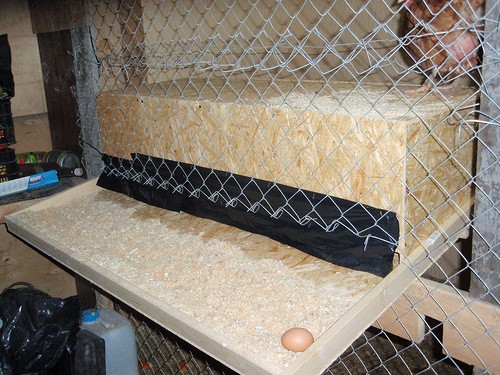
Nest with egg box
In the event that you fail to visit the chicken coop with enviable regularity to collect eggs, the most right decision will make a do-it-yourself device with an egg collector. These nests are very popular. This one does not have big differences from other species, except that its bottom should have a slope. A function with such a bottom will help the eggs roll to the right place. For this you need:
- make a regular box (we have already described how to make it, so see above);
- replace a flat bottom with one that will stand on an inclined surface. 10 degrees is the best option;
- make a bottom hole, attach the tray;
- put a moderate amount of bedding, otherwise the chicken nest with the egg box will not be of any use, because the eggs will not be able to roll out.
There is another version of the box with an egg collector, but making it yourself is somewhat more difficult, and the angle of inclination will not be 10 degrees, but as much as 40. There will be more sections and tiers in such a nest. Usually poultry farmers make three or four tiers. The nest should have a greater height than usual - 50 cm from the floor. The rest of the dimensions are standard. Make a hole with a diameter of 10 centimeters in the very center of the floor so that the eggs roll into it.
Below is a tray. This will keep them safe and sound. Such a box is called "double bottom". That's all! As you can see, making a nest with an egg collector with your own hands is easy and simple if you approach the matter responsibly. And remember that the height of the chicken dwelling must be at least thirty centimeters!

Chicken nest with ladder
booth nest
It is almost an exact replica of a dog house. The dimensions are the same as in the previous instructions. To make a booth nest with your own hands, you must:
- make a box with the dimensions indicated earlier, only without the front wall;
- take plywood or a board, cut a large enough hole on it. Its diameter should allow the hens to climb into the nest (more than 10 cm);
- insert the front wall separately and cover the cozy nest with bedding.
Making a wireframe
How many types of nests are there for building a chicken coop? There are many, and one of them is a frame. To make it, you need to make a frame for mounting from the bottom, top and side. Thanks to her, the nest will turn out to be much stronger and more reliable. For the manufacture of the frame, you can not do without wooden blocks 40 centimeters long. Fasten the two structures to make a square, pin the bars to them.
Pay attention to the front part of the bottom of the nest - it needs to be upholstered with a horizontal bar (width - 10 centimeters). Doing something with your own hands is a fascinating process. As you know, you do not need a lot of strength and knowledge. The size is the same in almost all cases. Tools - hammer and nails. The height from the floor is more than 30 centimeters. Here are the basic rules that you need to remember in order to be satisfied with the work with your own hands and create conditions for the hens so that they can safely rush.

Laying hen nest
How to accustom a laying hen to the nest?
And now a few words about how to train a chicken to rush in the right place. For this it is necessary.
To teach a chicken to a nest, you just need to follow these rules, and soon you will see what a wonderful result the nests that you made with your own hands give.
Laying hens are the most popular poultry in farms. It is convenient to keep them both in poultry houses and in cages, while chickens are unpretentious in their care. Quickly pay back the cost of their maintenance.
In order not to have to look for eggs laid by chickens throughout the poultry house, you need to take care of arranging a nest in which the hens will rush and incubate eggs.
With a nest, all the actions of the layers will be under your control, while there is no need to buy a perch in the store. Elementary options, in which laying hens will be comfortable, can be made on their own from inexpensive improvised materials.
Perches for laying hens can be divided into the following types:
- Box for hens of egg breeds. Outwardly, it looks like a box house with an opening. Inside such a box, a bird can comfortably accommodate and carry eggs in privacy. It is enough to close the chicken inside and she will quickly learn to rush in the nest. The number of cells inside the house can be different, according to your desire.
- Nests for laying hens with egg collector. This is the most convenient option, although it will take the longest to tinker with if you decide to assemble it yourself. The essence of the device is to ensure the least contact of the bird with the laid egg, which the farmer will take from a special pallet, where it will fall on an inclined floor or through a hole in the nest.
- Homemade models from boxes and baskets. Simple options are optimal for a small number of birds, as well as if you plan to breed for a short time. If the recommended standards are observed when preparing the roost, the hens will not feel discomfort and will rush no worse than in the purchased version.


What are the best nest sizes for chickens?
No matter what kind of homemade nest you plan on using, the size standards are the same for everyone.
The depth of the house should be at least 30 cm, the same amount is required for the width and height of nests for laying hens.
If the house is made for chickens of meat breeds, it is better to take care of more spacious options and ensure a size of at least 35x35x35 cm.
Materials must be polished before use. All protruding parts are rubbed with a needle file or cut off with a grinder so that the birds do not get hurt.
We make the right nests for laying hens with our own hands
The easiest way to get a container for hatching eggs is to use plastic or wooden crates, baskets or boxes. Sawdust, hay or straw are placed inside and placed in a secluded corner. Boxes can be placed in tiers. No more than three chickens can be in one box at the same time.
Those who want to create a more complex and solid model should pay attention to the following two options.
Option 1 - nest box

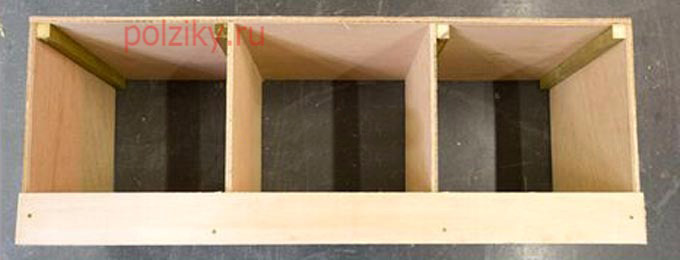
For work you will need:
- boards or plywood
- screws or nails
- hammer or screwdriver
- saw and jigsaw,
- stapler,
- Styrofoam.
VIDEO DESCRIPTION
Operating procedure:
- Finish the plywood with sandpaper.
- Cut the plywood according to the dimensions of the nest (at the rate of 35x35x35 cm or more).
- Put together a box, from the inside, strengthen it at the corners with a beam.
- File protruding nails.
- Make an “entrance” for the structure in the form of an open front or a round hole.
- Fix the take-off platform - a horizontal bar along the entire length of the structure.
- Lay soft material on the bottom.
- Install the nest at a height of at least 30 cm from the floor. Wall mounting is not recommended. For fastening, scaffolds are made from boards to which the structure is attached.
Option 2 - nest with egg collector
A perch with an egg box can be made from a finished box if it fits the size, or put together from plywood or planks.
VIDEO INSTRUCTION
You will also need:
- container for eggs (you can use a vegetable shelf for the refrigerator or another container),
- hammer,
- screwdriver or screwdriver for self-tapping screws,
- screws or nails
- metal mesh,
- saw.
Operating procedure:
- Put together a box from chipboard or plywood without a top and front. The dimensions of the box should be comfortable for the chicken.
- Attach an inclined plane to the bottom of the box (in this example, a grid). It will go down to the back wall.
- Make a hole in the back of the box through which the eggs will fall into the container.
- Attach a container to the back of the box, line it with soft material.
- It is recommended to cover the egg hole with a terry cloth to soften the fall.
- Place a bird bed inside the box.


In order for the eggs to roll into the tray unhindered, it is not recommended to put a lot of bedding, and softening material must be in the tray itself.
Where is the best place to place homemade nests in a chicken coop
Even the most comfortable nest will be useless if it is placed in the chicken coop incorrectly. It is important to take into account the physiological characteristics of chickens. To do this, farmers recommend adhering to the following rules:
- ensure the height of the house above the floor at a height of at least 30 cm,
- the minimum section of the perch for chickens should be at least 5x2 cm, it is fixed at a distance of 10 cm from the entrance,
- the best option for flooring is sawdust and hay,
- so that the structure is well ventilated, ventilation holes or a mesh bottom are made in the flooring,
- the nest should be in a dark secluded place,
- do not install a perch near the entrance to the chicken coop, even if it is well heated, the layers in the draft will get sick, and the eggs will quickly deteriorate.
- the structure cannot be fixed directly to the wall due to the fragility of the fasteners.
- you can not install a nest in wet places of the chicken coop, which can contribute to the development of colds in chickens and reduce productivity.
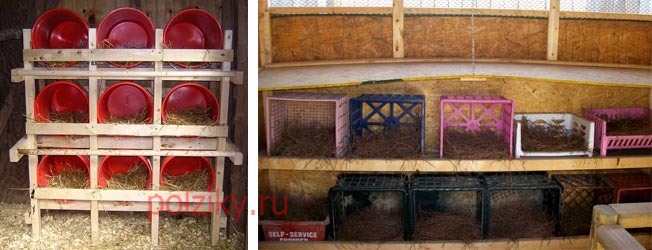
 An easy way to build chicken nests with an egg box
An easy way to build chicken nests with an egg box Nests should be easy to clean and disinfect, so it is necessary to provide easy access to the egg tray, as well as to the flooring.
If the birds do not lay eggs in the new nest, then you missed some detail and, unfortunately, the design will have to be redone.



